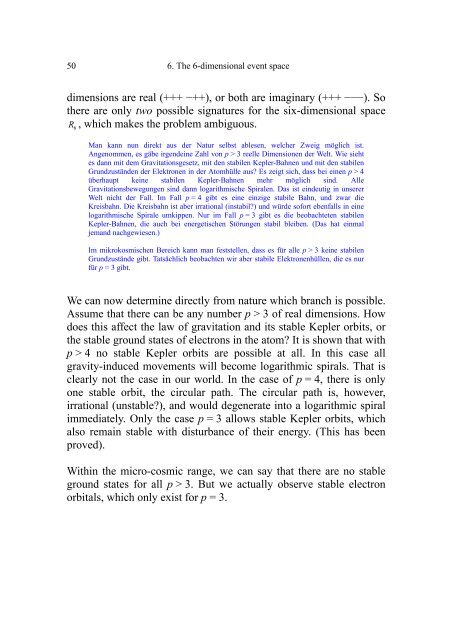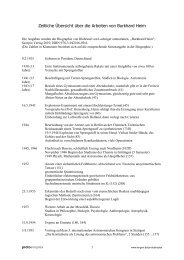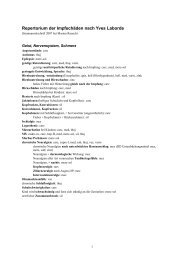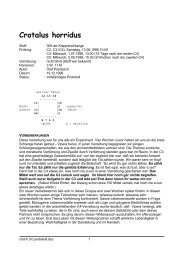K - engon.de
K - engon.de
K - engon.de
Erfolgreiche ePaper selbst erstellen
Machen Sie aus Ihren PDF Publikationen ein blätterbares Flipbook mit unserer einzigartigen Google optimierten e-Paper Software.
50 6. The 6-dimensional event space<br />
dimensions are real (+++ −++), or both are imaginary (+++ −−−). So<br />
there are only two possible signatures for the six-dimensional space<br />
R , which makes the problem ambiguous.<br />
6<br />
Man kann nun direkt aus <strong>de</strong>r Natur selbst ablesen, welcher Zweig möglich ist.<br />
Angenommen, es gäbe irgen<strong>de</strong>ine Zahl von p > 3 reelle Dimensionen <strong>de</strong>r Welt. Wie sieht<br />
es dann mit <strong>de</strong>m Gravitationsgesetz, mit <strong>de</strong>n stabilen Kepler-Bahnen und mit <strong>de</strong>n stabilen<br />
Grundzustän<strong>de</strong>n <strong>de</strong>r Elektronen in <strong>de</strong>r Atomhülle aus? Es zeigt sich, dass bei einen p > 4<br />
überhaupt keine stabilen Kepler-Bahnen mehr möglich sind. Alle<br />
Gravitationsbewegungen sind dann logarithmische Spiralen. Das ist ein<strong>de</strong>utig in unserer<br />
Welt nicht <strong>de</strong>r Fall. Im Fall p = 4 gibt es eine einzige stabile Bahn, und zwar die<br />
Kreisbahn. Die Kreisbahn ist aber irrational (instabil?) und wür<strong>de</strong> sofort ebenfalls in eine<br />
logarithmische Spirale umkippen. Nur im Fall p = 3 gibt es die beobachteten stabilen<br />
Kepler-Bahnen, die auch bei energetischen Störungen stabil bleiben. (Das hat einmal<br />
jemand nachgewiesen.)<br />
Im mikrokosmischen Bereich kann man feststellen, dass es für alle p > 3 keine stabilen<br />
Grundzustän<strong>de</strong> gibt. Tatsächlich beobachten wir aber stabile Elektronenhüllen, die es nur<br />
für p = 3 gibt.<br />
We can now <strong>de</strong>termine directly from nature which branch is possible.<br />
Assume that there can be any number p > 3 of real dimensions. How<br />
does this affect the law of gravitation and its stable Kepler orbits, or<br />
the stable ground states of electrons in the atom? It is shown that with<br />
p > 4 no stable Kepler orbits are possible at all. In this case all<br />
gravity-induced movements will become logarithmic spirals. That is<br />
clearly not the case in our world. In the case of p = 4, there is only<br />
one stable orbit, the circular path. The circular path is, however,<br />
irrational (unstable?), and would <strong>de</strong>generate into a logarithmic spiral<br />
immediately. Only the case p = 3 allows stable Kepler orbits, which<br />
also remain stable with disturbance of their energy. (This has been<br />
proved).<br />
Within the micro-cosmic range, we can say that there are no stable<br />
ground states for all p > 3. But we actually observe stable electron<br />
orbitals, which only exist for p = 3.







